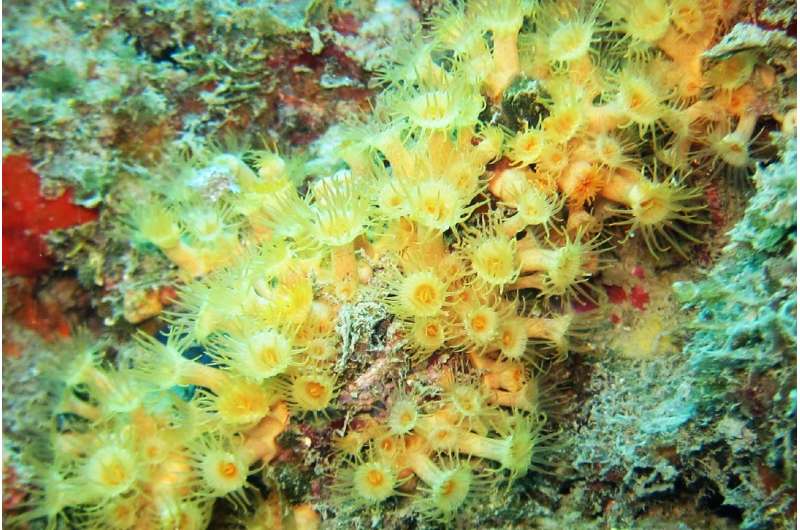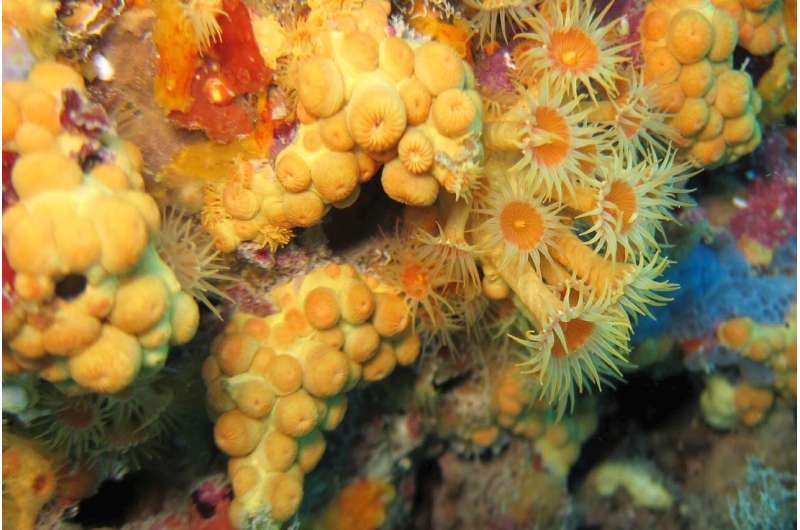Is it one or two species? The case of the cluster anemones

If you dive in the Mediterranean Sea, the cluster anemone is among the most fascinating and magnificent corals you could see. You can find it on rocks or sponges, in scarcely lit areas such as sea caves and gorges, where it clusters in dense agglomerations resembling yellow and orange carpets. In a study published in Scientific Reports, a research group of the University of Bologna found evidence that some corals commonly labeled as "cluster anemones" may belong to different species.
Indeed, there are two types of Parazoanthus axinellae and they differ in size, color and preferred substratum. Researchers sampled these corals in 11 locations of the Mediterranean Sea—from Banyuls-Sur-Mer (France) to Rovinj (Croatia), through Portofino, Olbia, Gallipoli and Chioggia (Italy)—and compared their DNA.
"We found evidence of marked genetic isolation between these two morphotypes of Parazoanthus axinellae. This leads us to believe that they may belong to two different species," explains Federica Constantini, one of the authors of the study who is also a professor at the Department of Biology, Geology and Environmental Sciences of the University of Bologna. "We will need further investigations to confirm these hypotheses. Information on species composition and marine populations connectivity patterns is fundamental to devise effective actions for safeguarding biodiversity in the Mediterranean Sea."
Which are, then, these two types of cluster anemone and how are they different? The first type (also known as "Slender" type) is spread across the entire Mediterranean Sea (including the Adriatic Coast) and presents a light-yellow color, an elongated trunk and long, thin tentacles. The second type (also known as "Stocky" type) is to be found in the north-western Mediterranean and presents a deep orange color, and a shorter, thicker trunk and tentacles. Moreover, the "Slender" morphotype mainly lives on the sponges of the genus Axinella, while the "Stocky" type lives primarily on rocky substrata.

Through their analyses, researchers also found that the "Slender" morphotype is genetically closer to two coral species that also colonize sponges but live in the Caribbean (Parazoanthus anguicomus and Parazoanthus capensis). On the other hand, the "Stocky" morphotype revealed genetic similarities with coral species that live in the shallow waters of the Pacific Ocean (Parazoanthus elongatus and Parazoanthus juanfernandezii) and with one species that instead lives in the deep waters of the Eastern Atlantic Ocean (Parazoanthus aliceae). None of these species was ever found colonizing sponges as they live primarily on rocky substrata.
In recent years, cluster anemones have experienced high mortality rates in some areas of the north-western Mediterranean because the temperature of the water is unusually high and periods of high temperatures are unusually long. These phenomena caused the proliferation of cyanobacteria that weakened the corals and, in some cases, led to the death of the corals themselves.
"The existence of 'complex of species' may render the management and conservation strategies of these corals difficult. Indeed, different species may present distinctive characteristics. For example, they may present different resistance to climate change-induced stress. These peculiarities could call for different management strategies," says Professor Costantini. "Finally, it should be taken into consideration that the diversity we observed within the Parazoanthidae family may be also found among other species that live in the fragile and delicate coralligenous habitat of the Mediterranean Sea."
More information: Adriana Villamor et al, Evidence of genetic isolation between two Mediterranean morphotypes of Parazoanthus axinellae, Scientific Reports (2020). DOI: 10.1038/s41598-020-70770-z
Journal information: Scientific Reports
Provided by Università di Bologna


















